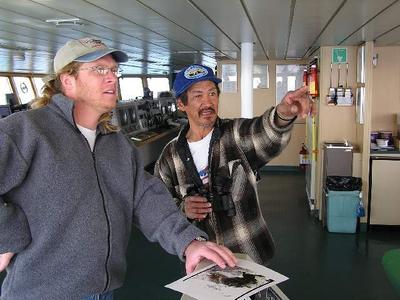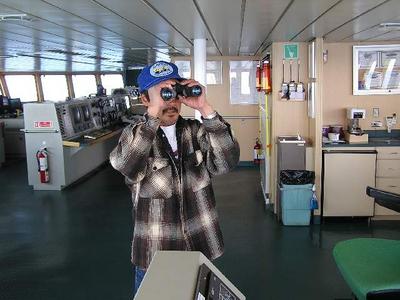19 July, 2003
We have emerged from the northern mists of the deep ocean basin
(nearly 4000 meters) to the shallow waters (50 meters) of the
continental shelf near the Alaskan shore.
Today the helicopter drops-off our first community parcticipant, Chuck
Menadalook from Little Diomede Island, and picks-up another, Luther
Leavitt of Barrow. They are part of a National Science Foundation
program that helps keep the local communities informed about the
research that is being done in their region.
Both Chuck and Luther are Inupiat Eskimos. Inupiat means "the real
people." Their creativity and survival skills have allowed the
Inupiat to inhabit the Arctic for thousands of years. Knowledge of
this harsh environment and how to make use of its resources were
essential to the traditional Inupiat.
Whaling has always been - and remains today - the center of Inupiat
life. Each spring the Inupiat spend several weeks camped on the ice
hunting Bowhead Whales in small areas of open water. This requires a
great deal of patience since the hunter must spend long hours in
silence waiting near a hole in the ice for a whale to rise to the
surface for air. When they spot a whale nearby, the hunting party
launches a skin boat, called an umiaq, which is usually made from the
hide of a seal and can carry up to 10 or 12 people.
Traditionally, stone-tipped harpoons were thrown at the whale.
Today, a combination of explosive darts and shouldered guns are used.
Needless to say, it's a tricky, if not hazardous endeavor to
successfully harvest a 60 foot, 120,000 pound Bowhead. Much of this
depends on the skills, knowledge, and hunting prowess of the group's
whaling captain, or "umialik," who knows how to approach the whale
safely. The umialik is a respected leader that is an accomplished
hunter and generous provider.
It happens that Luther is an umialik that has taken 8 whales with his
crew of 7 in his Bearded Seal-skin umiaq; however, Luther prefers to
hunt smaller Bowheads, about 24 feet in length, believing the meat to
be tenderer, and therefore, tasting much better.
If successful, the hunt's bounty is shared later (in early summer)
with the entire community at a Nalukataq. This whale festival is a
celebration that features a public feast, singing and dancing, and
perhaps most fun of all, a blanket toss. I was fortunate to
parcticipate in several Nalukataqs when I worked in Barrow two summers
ago. It was very interesting tasting the muktuk (skin with
blubber), qua (meat), and the best of all, although I'm not sure how
to spell it, mickigut, which is the whale meat fermented in its own
blood. That is Luther's favorite part of the whale and he claims
that he can eat mickigut as many as five times a day.
This past spring, Luther thought that Barrow hunters harvested 8 or 9
whales, and the year before, maybe 20, so one can see that it is
hard to predict each season's outcome. Respectful and appropriate
behaviors are still believed to be important during the whaling
season in order for a whale to give itself to a hunter.

Luther pointing out surfacing Gray Whales to marine technician Brent Evers from the Palmer's bridge.

Chuck Mendalook (to the right) as "sample cop" keeping the order as Scripps marine technician Paul Ellis draws an oxygen sample from the rosette.

Luther Leavitt of Barrow scanning the horizon for marine mammals.
Contact the TEA in the field at
.
If you cannot connect through your browser, copy the
TEA's e-mail address in the "To:" line of
your favorite e-mail package.
|
